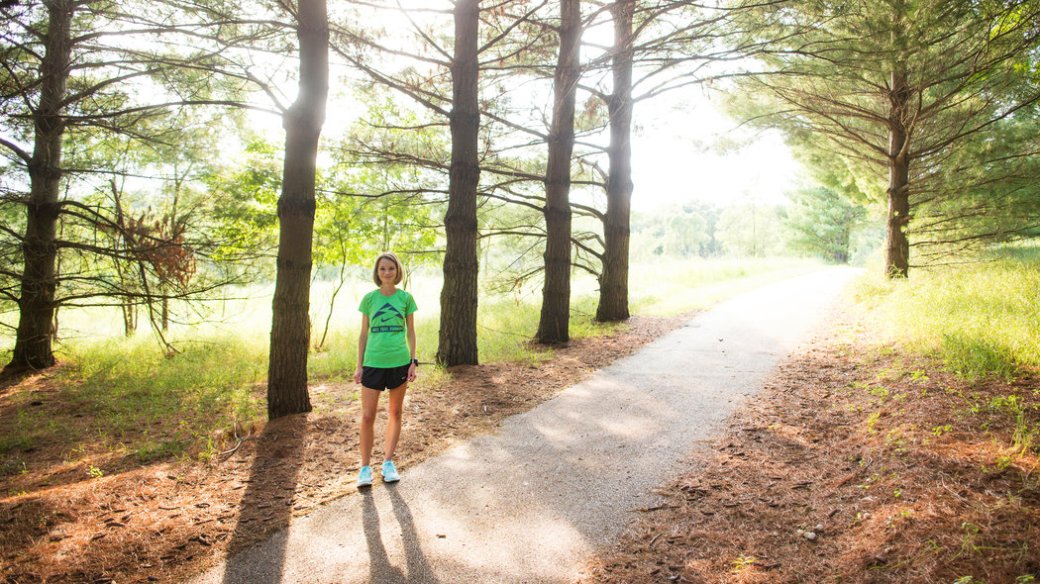She May Be Small, but Kaci Lickteig (the Pixie Ninja) Is a Giant in Ultrarunning
OMAHA — Kaci Lickteig, in her creative efforts to mimic various mountain ranges that are not native to Nebraska, does some of her most important training here on a nondescript stretch of road that she calls Pacific Hill.
The incline, gentle at first, starts where Pacific Street intersects with 153rd Street and then climbs more sharply for seven-tenths of a mile until it reaches a green electrical box opposite Millard North High School, just short of Dunkin’ Donuts and Rusty Nail Pub. This is the spot where Lickteig, a familiar presence to motorists, stops so she can run back down the hill so she can run back up the hill. She often repeats this exercise six, seven or eight times.
“I know it doesn’t look like much,” Lickteig said. “But you have to find your way, one way or another.”
Lickteig, 28, has defied her geography (the flat plains of the Midwest) and her background (she barely ran as a teenager) to emerge as one of the country’s top female ultramarathoners.
On June 28, Lickteig placed second at the Western States 100-Mile Endurance Run, one of the sport’s most prestigious events, by traversing an undulating course in Northern California in 19 hours 20 minutes 31 seconds. She overtook several competitors in the race’s late stages, signaling her arrival in boldface type.
“It was about the hardest I’ve ever run in my life,” said Miguel Ordorica, her close friend and training partner, who jumped into the fray to pace her — a perfectly legal tactic — for the final 38.5 miles.
Ultrarunning is a peculiar endeavor, reserved for athletes who push themselves to the brink of physical and emotional exhaustion. Anything longer than a marathon, which measures 26.2 miles, typically qualifies as an ultramarathon. The longer the race, the stronger Lickteig — all 90 to 95 pounds of her, depending on the day — seems to get. Friends know her as the Pixie Ninja.
“I tell her that she can step on the starting line for any ultramarathon, and she should expect to win,” said Jason Koop, her coach. “That’s how good she is, and that’s how hard she’s trained.”
Lickteig, who works full time as a physical therapist at an area hospital, plans to celebrate her 29th birthday on Friday by running 29 miles. But she is not wedded to sentimentality. She breaks out the sneakers she wore for her first 100-mile race — the Black Hills 100, held in Sturgis, S.D., which she won in 2013 — whenever she mows her lawn.
Still, she savors every race, every training session, every chance to run. She is not motivated by money or fame. The sport provides little of either. But her drive is boundless. She wears a GPS watch and charts her mileage on Strava.com, a website that makes all her workouts public. She regularly logs 110 to 120 miles a week.
“A lot of people want to know: What are these people doing to prepare for these races?” Lickteig said. “I’ve got nothing to hide. It’s just running. If you can train the way I train, more power to you.”
Koop, who coaches Lickteig remotely from Colorado, said her slight build probably worked as a biomechanical advantage. Rather than trudge across trails for endless miles, Lickteig almost floats, her stride light and loping. She avoids a lot of unnecessary wear and tear, he said.
Then again, Lickteig comes from hardy stock. Her mother, Lori Leonard, worked as a welder for nearly 25 years before she gave it up after having four vertebrae fused in her neck. She now loads equipment onto semitrailers and rail cars.
“At least I got out from under that welding hood,” said Leonard, who likes to ride motorcycles in her spare time.
Like her daughter, Leonard, 53, is a relative newcomer to the select world of ultramarathons, having completed two 50-mile races of her own. But her daughter’s feats astound her.
“She’s a little animal,” Leonard said.
